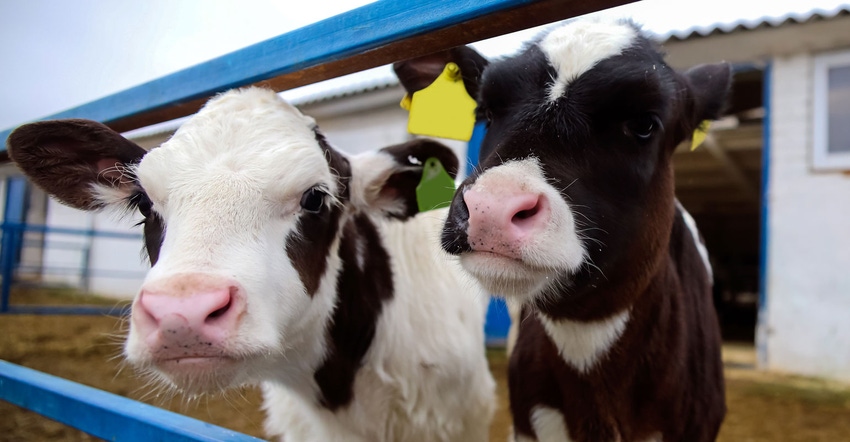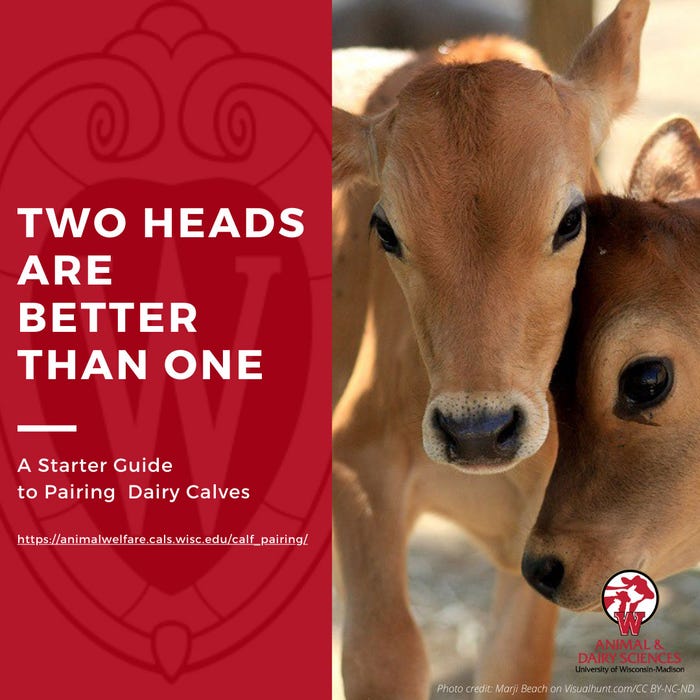November 19, 2020

At the end of 2019, a group of us who work on dairy calf Extension outreach conducted a survey on current practices for raising dairy calves. Most of the 400 producers who responded raise their preweaned calves in individual housing, but many farms raise calves in pairs or groups. In recent years, interest has been growing in the topic of pair or group housing of dairy calves. Of the producers raising their calves individually, nearly 40% expressed interest in learning more about pair or group housing. Even many of those already raising calves in pairs or groups indicated they wanted to learn more.
We have created a series of seven articles about pairing or group housing of preweaned dairy calves. Throughout this guide, called “Two Heads Are Better Than One: A Starter Guide to Pairing Dairy Calves,” we cover best practices to promote good health and welfare in calves raised in pairs or groups.
The article titles and topics are as follows:
1. “Why all the fuss about pair housing?” In the introductory article, we review the research on benefits for calf development, grain intake and growth, and consumer acceptance. We also discuss the mixed impacts of group housing on calf health and introduce the subsequent articles on best practices to promote healthy calves.
2. “Benchmarks for calf health before pair housing.” We provide benchmarks for transfer of passive immunity, morbidity and mortality. Measuring these outcomes can help determine if the time is right for a farm to move to pair or group housing of calves.
3. “Hygiene practices.” We cover best practices for reducing the spread of disease, including sanitation and bedding.
4. “Options for housing pairs or groups.” Social housing can be done in many ways, as we found in our survey. We describe the various practices producers can use to house calves in social groups. We also discuss the latest recommendations on space allowance.
5. “Grouping strategies.” Here we discuss group size, age range within a group, the age calves enter a group, and strategies for pen and barn moves after weaning.
6. “Feeding practices and reducing cross sucking.” We review the research on milk or milk replacer allowance, feeding methods, and weaning strategies to reduce unwanted behaviors like cross sucking, pen sucking and milk stealing.
7. “Disbudding and dehorning considerations.” We present the latest standards of care for disbudding, including considerations for pair- or group-housed calves.
The articles cover best practices informed by scientific evidence. We also address common questions we have received at workshops or when visiting with producers. We draw upon our expertise as researchers in calf health and welfare, as well as our practical experience as Extension specialists, agriculture educators and bovine veterinary practitioners.

I created this guide, with contributions from the following experts in dairy calf welfare: Sarah Adcock, Ph.D., University of Wisconsin-Madison Department of Animal and Dairy Sciences; Joao Costa, Ph.D., University of Kentucky Department of Animal and Food Sciences; and Emily Miller-Cushon, Ph.D., University of Florida Department of Animal Sciences.
Also providing input were experts in calf health and bovine veterinary medicine: Theresa Ollivett, D.V.M., Ph.D., and Courtney Halbach, MBA, UW-Madison School of Veterinary Medicine Department of Medical Sciences; and Sandy Stuttgen, D.V.M., Extension ag educator in Taylor County, Wis. Tina Kohlman, Extension dairy and livestock agent in Fond du Lac County, Wis., contributed expertise in dairy calf and heifer management.
The guide can be found on UW-Madison’s Animal Welfare Science webpage.
Van Os is an assistant professor and Extension specialist in animal welfare with the Department of Animal and Dairy Sciences, University of Wisconsin-Madison. This column is provided by the University of Wisconsin-Extension Dairy Team.
You May Also Like




